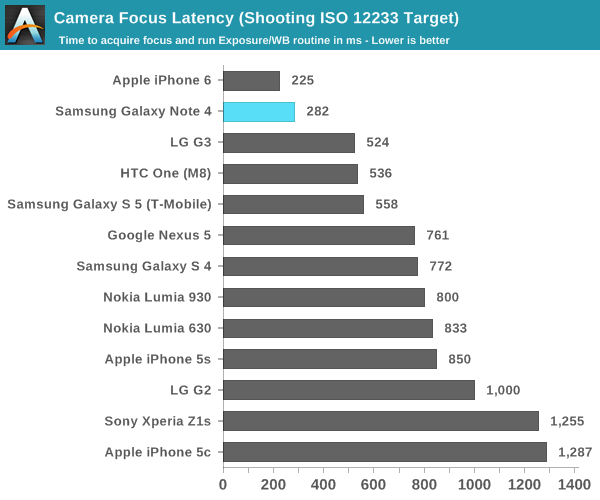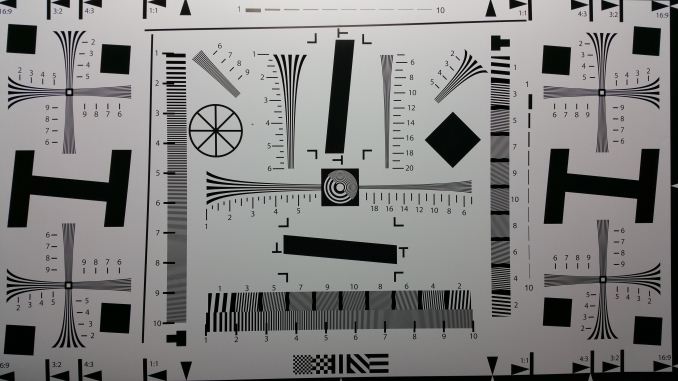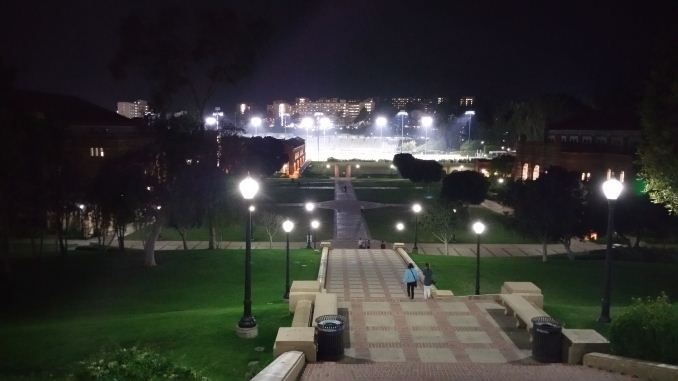The Samsung Galaxy Note 4 Review
by Joshua Ho on October 15, 2014 9:00 AM EST- Posted in
- Smartphones
- Samsung
- Android
- Mobile
- Galaxy Note 4
Camera
While the 16MP camera of the Galaxy Note 4 is mostly what we would expect, Samsung has really changed things up with the addition of OIS. Outside of this addition and the Sony IMX240 sensor, there’s really not a lot of change when it comes to the Galaxy Note 4. This means that we see the same 31mm equivalent focal length and F/2.27 aperture. At this point, it seems that OIS has finally reached mainstream adoption as both Samsung and Apple are shipping OIS solutions on their phones. The front facing camera is noticeably different though, with a Samsung S5K6D1YX sensor that I haven't seen elsewhere.
However, before we get into the proper image quality analysis I wanted to first cover shot to shot latency and focus/AE latency, as both are critical to a good image capture experience. Even if it’s possible to get amazing photos from a camera, it doesn’t really matter if the moment is missed. In order to test this, we look at the ideal case, which is when the phone is pointed at the ISO chart with bright lighting to maximize contrast.


As one can see in the graphs above, capture latency and focus latency are quite competitive with on the Note 4. However, there is one crucial detail that the focus latency graph misses, which is that Samsung doesn’t have continuous auto-focus in preview with the Note 4. As a result, there’s realistically an additional latency period before the auto-focus begins to run. The result is that the total time from out of focus to in focus is realistically closer to 800ms, but if one immediately taps the display to begin an AF run it’s possible to achieve the lower bound value, which is just south of 300ms.
Still Image Performance
While I'm still working on moving towards a better test for cameras, for now we have our standard photo comparisons that should give a good idea of what to expect from a smartphone camera in comparison to other cameras. Our first test is the standard ISO chart, which allows for a good test of maximum resolution.

For this first test, it seems that Samsung hasn't really changed much when it comes to maximum resolution, and in general the Note 4 produces similar output to the Galaxy S5. To verify this and a test of dynamic range, we'll look at a landscape shot next.
In this test, we see that the Galaxy Note 4 generally does well with detail and dynamic range as the landscape is generally well-detailed, although there's quite a bit of detail that seems to be smudged away on the grass as it seems to be a flat green texture for the most part. There's also noticeable color artifacting on the bleachers in the distance. We'll look at the same scene in low light to get a better idea for what the Note 4 really brings to the table.
Here, in low light we see significant improvements in image quality when comparing the Galaxy S5 to the Galaxy Note 4. The iPhone 6 Plus and Note 4 are quite close in overal quality, but looking at the brick building on the right of the image shows that the iPhone 6 Plus is maintaining a higher level of detail in this scene.
In the case of HDR, Samsung continues to do a great job with their implementation. For the most part this feature is successfully implemented with no real halos or other artifacts even when there are moving objects in the shot. This is likely to be implemented through on-sensor HDR rather than image combination.





































195 Comments
View All Comments
dakishimesan - Wednesday, October 15, 2014 - link
You can't ignore maximum brightness. OLED screens have a high contrast ratio because their black levels are very deep, which offsets the lower brightness to still give it a high ratio. But maximum brightness still matters for visibility outside.theduckofdeath - Wednesday, October 15, 2014 - link
You can however dismiss its importance. If the dynamic range is below the thousands on one tech and maybe above the millions on the other tech, other numbers suddenly become really, really irrelevant.JoshHo - Monday, October 27, 2014 - link
This is technically inaccurate. Outdoor visibility is primarily determined by maximum brightness and diffuse reflectance, not native contrast.jnb - Wednesday, October 15, 2014 - link
I played around with an iPhone 6 Plus and the Note 4 at Best Buy the other day. I thought there was a big difference in the display with the Note 4 being much better. It is interesting to see a review like this say there are basically equal. It goes to show that you should really look at them in person and form your own opinion. These numbers don't mean anything to an average person.melgross - Wednesday, October 15, 2014 - link
That's very misleading. While the blacks are just a small bit better than the best LCD displays, the whites are half as bright. In normal lighting, the much dimmer AMOLED displays will look fine, but outside, in direct sunlight, they will be washed out.The GS5 is definitely not more readable outside. So just go ahead and ignore reality. Brightness is directly responsible for readability outside. It's not magic.
Tams80 - Thursday, October 16, 2014 - link
It's not just brightness. I don't know what Samsung have done here, but Nokia CBD (proper CBD) increased sunlight readability without just increasing screen brightness.theduckofdeath - Thursday, October 16, 2014 - link
It's not "a small bit better", it's a much bigger difference than what you get between TN and IPS. 100's times bigger in fact.skinygeek - Wednesday, October 15, 2014 - link
Wondering how the Battery life of Exynos Variant would be . The 20nm Tech should give it an edge.danstek - Wednesday, October 15, 2014 - link
Is the graph comparing camera focus latency missing? Not showing up for me.juicytuna - Sunday, October 19, 2014 - link
It's there now, but unfortunately too late as most of the sites readership will miss out on knowing how awesomely fast the camera is.A stark contrast with the iPhone 6 review where the phase detect autofocus was put on pedestal and showered with confetti.